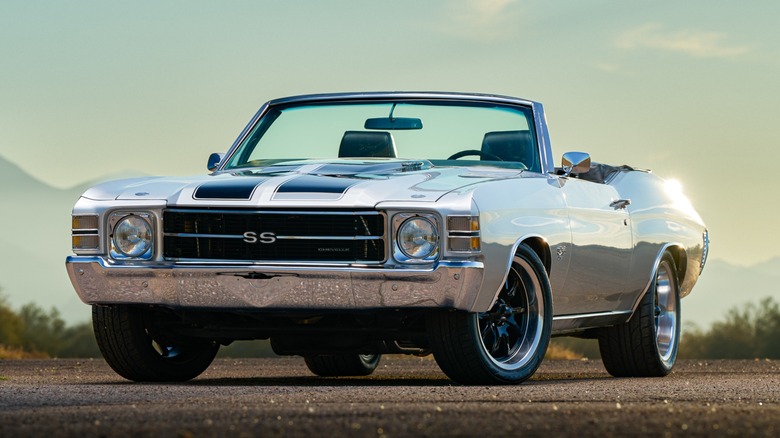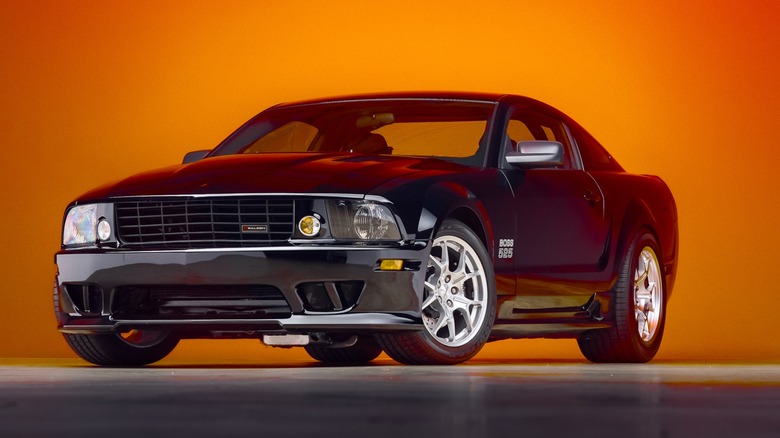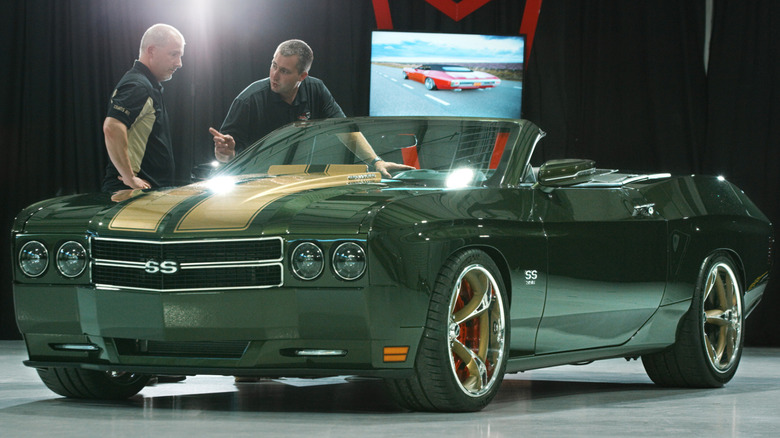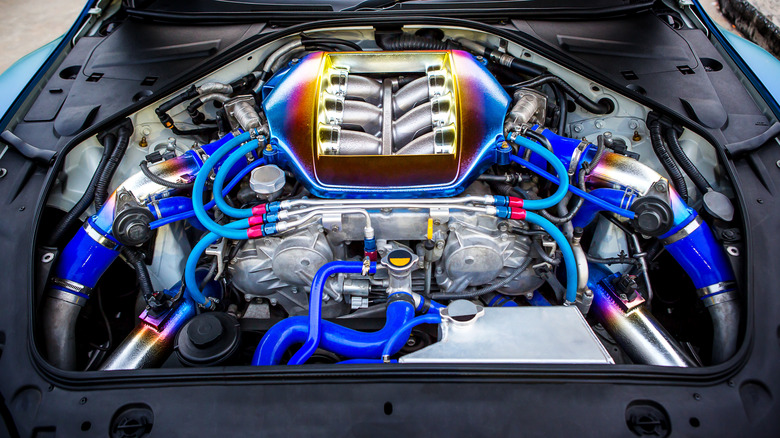Everything Chevelle Fans Should Know About The 70/SS Concept
Most car fans think of the late 1960s and early 1970s as the definitive muscle car era, during which American manufacturers produced some legendary cars. In the broadest sense, muscle cars are equipped with powerful, big-block engines, offering brutish performance and a lot of speed in a straight line. Some consider the 1949 Oldsmobile 88 the original muscle car, while others claim it all started with the release of the Pontiac GTO and Ford Mustang in 1964.
The truth is more complicated. The United States has enjoyed multiple eras of muscle power — some good, some bad. Generations of the Firebird and Camaro both outlasted the so-called "muscle car era," spanning four decades of performance. The Mustang has not been out of production since its inception in 1964.
Governmental regulation and geopolitical fuel crises informed the shape and feel of American muscle cars, sending them through ups and downs in terms of performance, but the public never lost its hunger. The early 2000s saw a resurgence of muscle cars thanks to technological improvements that made powerful V8s that met governmental standards feasible.
Muscle Car Rebirth
The fifth-generation Mustang's release in 2005 kicked off a muscle renaissance. The only other nameplates to survive the century, the Camaro and Firebird, had gone out of production in 2002, which meant Ford was the only original muscle builder still in the field. However, the new Mustang's retro-fastback design proved there was still an enormous appetite in the contemporary market. Within a few years, consumers saw the resurrection of some famous names from the golden era.
Dodge was the first to join the fray, reviving the Charger for the 2006 model year — this time as a four-door sedan. The SRT-8 came with a 6.1-liter V8, producing 425 horsepower. Gas prices be damned, this was promising for muscle car fans that suffered during the 1980s and 1990s. In 2008, Pontiac's last gasp reintroduced the GTO plate. The same year, Dodge fully committed to the muscle renaissance with the Challenger. The Camaro rose from the dead two years after that, in 2010.
Some names were noticeably absent. There would be no production return of the Firebird, as Pontiac ceased to exist entirely. Road Runners, GTXs, and Barracudas would remain in the grave, along with Plymouth, which ceased operation in 2001. But there was one nameplate that defined the golden era perhaps more than any other, the king of muscle, a definer of the genre: the Chevrolet Chevelle.
The Original 1970 Chevelle SS
The Chevelle name invokes the lopey rumble of a huge V8 tugging at its leash, the curved haunches of a beast ready to launch itself off the line, the exhaust smell, and the drag strip roar.
1970 proved to be the high water mark of the original muscle craze. GM, Mopar, and Ford had competed with each other for market share for half a decade, each bidding for favored status among consumers. Many muscle cars were in their second generation, issues had been ironed out, engines had been beefed up, and suspensions had improved. More importantly, the 1970 Clean Air Act had not taken effect during design and production for the 1970 model year.
The Chevelle had undergone a redesign for 1968, making 1970 the midpoint of the second generation. Chevrolet pulled no punches for its top-of-the-line iteration. The 1970 Chevelle SS 454 LS6 is one of the era's most powerful and sought-after muscle cars. Today, they are hard to find, and prohibitively expensive. The average second-gen goes for just north of $76,000, and that is just across the generation; rare models may fetch as much as a half-million at auction.
Unfortunately, the Chevelle nameplate received no resurrection from Chevy during the renaissance of the early 2000s. The Camaro, itself now on the chopping block, was as far as Chevrolet was willing to go. That's where Trans Am Worldwide comes in.
TransAm Worldwide
TransAm Worldwide is not associated with the Pontiac Firebird, at least not officially. The Tallahassee custom builder focuses on reimagining the muscle glory days by building on modern platforms. Founded by brothers Scott and Tod Womack, who got their start selling cars and car parts, the company goes beyond where the big manufacturers stopped by building custom muscle cars for limited production. The rebirth of the Camaro helped the company along the way, providing the base for many of its builds.
Though the Firebird never made it back from the dead, fans with deep pockets can buy modern-era Camaros refit to hearken back to the glory days of the second-generation Trans Am. Amongst the cars Trans Am Worldwide has developed are modern or performance versions of the GTO Judge and multiple Trans Ams, including versions that pay homage to the Bandit of "Smokey and The Bandit" fame, and the Super Duty Trans Ams of the early 1970s. Custom interiors, body kits, and major changes under the hood are all hallmarks of Trans Am Worldwide's ethos. But with a 7.4 liter 840 hp performance option, even those powerful cars can't touch their modern reimaginings.
Think of Trans Am Worldwide as building some high-end vintage restomod projects in a world where the gas crunch never killed the muscle craze, and you're close to getting the idea. But its latest project has really caught the attention of Chevelle lovers.
The 70/SS
Trans Am Worldwide shifted its focus from Pontiac to pay tribute to the 1970 Chevelle SS, one of the most expensive classic muscle cars today. It's based on the modern Camaro Alpha body platform shared by Cadillac's performance models, but that's where the similarities end. In fact, the only original piece of the body left in the Chevelle is the Camaro's windshield. Each body panel is constructed from carbon fiber and based on the dimensions of the original Chevelle.
Trim packages include a myriad of options between the 70/SS Base model, 70/SS 396 Heritage, and the top-tier 454 LS6X Limited Edition. The options also include a choice of a convertible for those who want to enjoy warp speed with the wind in their hair.
Under the hood, the Base model is powered by a pushrod LT-1 V8 from the Camaro SS, producing 450 horsepower and 455 lb-ft of torque. Six-speed manual or eight-speed automatic transmission options are up to the buyer. The rear-wheel drive powers the car to 60 mph in 4 seconds. But if that's not enough for you, a supercharged option pushes the number up to 675 hp. And if you really want to channel the king of muscle, a 454 cubic inch big-block is available, but unlike the original, this one is a twin-turbo creating an absolutely absurd 1,500 and 1,317 lb-ft of torque. TAW plans to build only 25 of the top-spec LS6X models, and at a starting price of $150,000, these cars are basically relegated to collectible status from the jump.
Future of the Chevelle and American muscle
If nothing else, the icon's rebirth indicates the enormous space the Chevelle occupies in the minds of car enthusiasts. American muscle has experienced its ups and downs, from the original museum pieces to the early 2000s return, and now into the current era where they're being phased out again. The Challenger, Charger, and Camaro are all due for major changes. Again, Ford stands at the forefront of internal combustion engine-powered muscle with its seventh-generation Mustang primed to carry the banner into the future.
However, that's not to say there isn't a future for powerful vehicles bearing respected nameplates. Production on the Camaro ended in January 2024, but the Charger and Challenger are headed for electrification. Chevrolet has hinted that the Camaro's story is not truly over either, but when and how it returns is still a matter of speculation. The big three American producers of powerful coupes are all taking different approaches for the future. America has turned heavily to the SUV, but it's safe to say there will always be a place for mind-bendingly fast cars. Just how much they draw from the golden era of American muscle remains to be seen.
A $150,000 limited edition custom version of old name badges is not the answer to the everyman power that the original muscle cars once represented. But as long as enthusiasts and gearheads like Trans Am Worldwide still seek to pay homage to past greats, there is hope for the rest of us.





